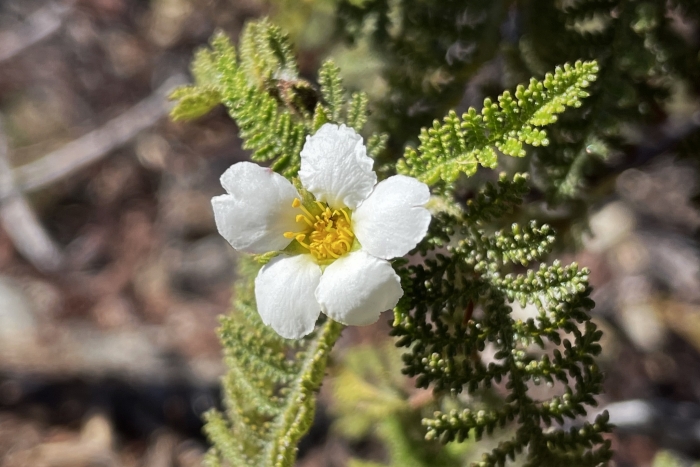Southern Mountain Misery
(Chamaebatia australis)
Southern Mountain Misery (Chamaebatia australis)
/
/

Madeleine Claire
CC BY 4.0
Image By:
Madeleine Claire
Recorded By:
Copyright:
CC BY 4.0
Copyright Notice:
Photo by: Madeleine Claire | License Type: CC BY 4.0 | License URL: http://creativecommons.org/licenses/by/4.0/ | Rights Holder: Madeleine Claire | Publisher: iNaturalist | Date Created: 2021-02-06T20:31:20Z |























Estimated Native Range
Summary
Chamaebatia australis, commonly known as Southern Mountain Misery, is an evergreen shrub native to the chaparral and mixed evergreen forests of California, including the coastal ranges and the Sierra Nevada foothills, as well as extending into Baja California. This species typically grows to a height of 1-3 feet (0.3-0.9 meters) and spreads 4-6 feet (1.2-1.8 meters) wide. Its dark bark contrasts with the delicate, fernlike foliage, which is highly aromatic and features 2-pinnate leaves, each leaflet further divided into smaller leaflets. The foliage has a unique, sticky texture due to glandular dots. Southern Mountain Misery blooms in late spring to early summer, producing roselike flowers with rounded white petals and prominent yellow centers filled with numerous stamens, which are moderately showy.
This shrub is valued for its drought tolerance, low maintenance requirements, and the textural contrast its fernlike leaves provide in the landscape. It is often used in native plant gardens, restoration projects, and as ground cover in dry, challenging sites. Southern Mountain Misery thrives in full sun to part shade and prefers well-drained soils, tolerating a range of soil types from sandy to loamy. It is adapted to periodic wildfires and can resprout from its root crown after fire. While generally disease-free, it can be sensitive to overwatering and root rot in poorly drained soils. Additionally, its common name reflects the sticky resin on its leaves, which can be a nuisance to some gardeners.CC BY-SA 4.0
This shrub is valued for its drought tolerance, low maintenance requirements, and the textural contrast its fernlike leaves provide in the landscape. It is often used in native plant gardens, restoration projects, and as ground cover in dry, challenging sites. Southern Mountain Misery thrives in full sun to part shade and prefers well-drained soils, tolerating a range of soil types from sandy to loamy. It is adapted to periodic wildfires and can resprout from its root crown after fire. While generally disease-free, it can be sensitive to overwatering and root rot in poorly drained soils. Additionally, its common name reflects the sticky resin on its leaves, which can be a nuisance to some gardeners.CC BY-SA 4.0
Plant Description
- Plant Type: Shrub
- Height: 1.5-5 feet
- Width: 3-9 feet
- Growth Rate: Moderate
- Flower Color: Yellow, White
- Flowering Season: Spring
- Leaf Retention: Evergreen
Growth Requirements
- Sun: Full Sun, Part Shade
- Water: Low
- Drainage: Fast
Common Uses
Erosion Control, Fire Resistant, Low Maintenance
Natural Habitat
Chaparral and mixed evergreen forests of California and Baja California
Other Names
Common Names: Southern Bearclover
Scientific Names: , Chamaebatia australis, Chamaebatia foliolosa var. australis,
GBIF Accepted Name: Chamaebatia australis (Brandegee) Abrams